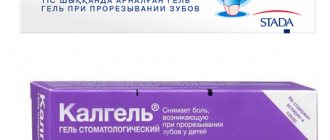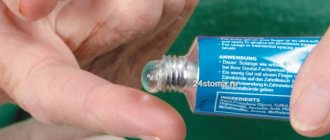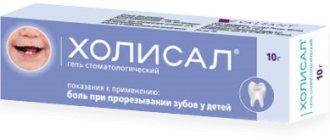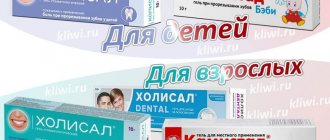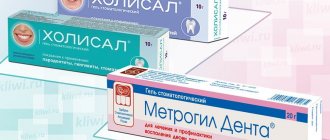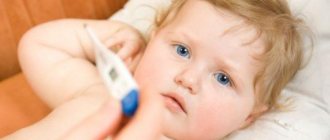Teething is a difficult period for babies and their parents. The process is accompanied by the baby crying, being capricious and refusing to eat. To relieve symptoms, pediatricians prescribe Kalgel for children's teeth.
The product is also used as part of complex therapy for dental diseases in children and adults (stomatitis, gingivitis). This is explained by the complex effect of the active components of the drug on the mucous membranes of the mouth. The composition of the gel and instructions for use must be studied in more detail before the first application.
Properties
Kalgel is distinguished by its combined action. Thanks to this, it can have several effects on problem areas of the oral mucosa at once. The gel quickly relieves symptoms characteristic of dental disorders.
Effects provided by the gel:
- Analgesic. This is achieved thanks to the anesthetic contained in the product. It is worth noting that the analgesic effect of the medication does not last long.
- Antimicrobial. The product inhibits the proliferation of pathogenic flora in the mouth, thereby preventing the development of complications against the background of the inflammatory process.
- Anti-inflammatory. The drug relieves the feeling of itching and the intensity of inflammation a few minutes after applying the gel to the gums. The condition of the babies quickly improves after applying the product.
The effect of Kalgel lasts for 2–3 hours. After this, the child will again be capricious and scratch his gums.
KALGEL OR CHOLISAL - WHAT IS MORE EFFECTIVE?
During teething in children, the likelihood of infection of the gum mucosa increases. To ease the pain and burning sensation, the baby begins to chew objects that he can reach. During the day, pathogenic bacteria and pathogenic fungi settle on toys or books. After their penetration into the oral cavity, there is a risk of an inflammatory process. The use of Cholisal or Kalgel will help prevent such negative developments. They are characterized by the following therapeutic properties:
- relief of inflammation and swelling of the gums;
- elimination of pain of any intensity;
- preventing the spread of infection to healthy areas of the oral cavity.
Cholisal fights inflammation much more effectively due to its active ingredients. They quickly destroy pathogenic microorganisms and disinfect mucous membranes. Kalgel relieves pain, burning, cutting and itching well. But it is used more for the prevention of bacterial and fungal infections. And to eliminate it, more powerful antimycotic and antimicrobial agents are needed.
RULES FOR SELECTION OF DOSAGE FORM
Kholisal is characterized by a significantly larger number of contraindications. The likelihood of developing side effects from using Kalgel is significantly lower. The dentist assesses the stage of the inflammatory process and the number of complications that have arisen. What is better for a child - Cholisal or Kalgel:
- Both gels eliminate pain within the first minutes after application to the gum mucosa;
- Kalgel is less toxic to the baby’s body;
- Cholisal has a wider spectrum of antimicrobial action;
- drugs are quickly absorbed by mucous membranes, which reduces the likelihood of ingestion;
- Cholisal better eliminates swelling, which increases pain.
When choosing a gel to relieve pain in the gums, the doctor is guided by the age of the young patient. The general state of health and the presence of diseases in the anamnesis must be taken into account.
DIFFERENCES
Dental gels differ from each other not only in composition and range of applications. What else is the difference between Kalgel and Cholisal:
- Kholisal has a more multifaceted therapeutic effect;
- Kids like Kalgel more in terms of taste;
- Dental gels have different mechanisms of pharmacological action.
For a small child, Kalgel is a safer drug.
If dental gel is accidentally swallowed, digestive and peristalsis disorders occur in rare cases. Kholisal has one significant drawback. It contains anise oil, which determines the taste and smell of the drug. After applying the product to the gums, increased salivation occurs. Human saliva contains enzymes that have medicinal properties:
- bactericidal;
- antifungal;
- antiseptic.
By adding anise oil, manufacturers enhanced the therapeutic effect of the dental drug. But small children do not have time to swallow saliva, they choke and are very frightened by this condition. This can negatively affect falling asleep and disrupt feeding patterns.
Composition and release form
The main active component in the structure of the drug is lidocaine (3.3 g). A local antiseptic affects only problem areas of the mucous membranes, without spreading to neighboring tissues. The analgesic effect is achieved by blocking sodium channels, which helps eliminate discomfort in the short term.
Another active substance in Kalgel is cetylpyridinium chloride (1 mg) - an antiseptic that prevents the active reproduction of pathogenic microorganisms.
Additional substances in Kalgel:
Viburkol suppositories for teething children
- xylitol – 140 mg;
- sorbitol – 210 mg;
- macrogol – 3.3 mg;
- glycerol – 70 mg,
- sodium saccharide – 1 mg;
- hyaetellose – 25 mg;
- levomenthol – 0.6 mg;
- citric acid – 1 mg;
- ethanol – 93.6.
In addition to the listed components, the gel structure also includes purified water and herbal flavors. The medicine is produced in aluminum tubes of 10 g.
The color of the gel is light brown, without any foreign impurities. It does not contain a strong taste or smell, so children are not capricious when using it during teething.
DESCRIPTION OF DRUGS
Cholisal is a transparent jelly-like substance without a distinct taste with a faint aroma of anise. Kalgel is a colorless mass with a gel consistency, a pleasant sweet taste and herbal odor. The drugs have advantages over antiseptic solutions and ointments:
- have an analgesic effect for several hours;
- do not require frequent use;
- During treatment, the baby’s diet is not disrupted.
Applying medications to your baby's gums before bed allows him to sleep peacefully all night without feeling pain or itching. Their use also becomes an excellent prevention of stomatitis by strengthening local immunity.
PHARMACHOLOGIC EFFECT
Medicines exhibit the same activity - analgesic, disinfectant, anti-inflammatory.
They have the ability to destroy bacteria, yeast-like fungi and even some viruses. The drugs effectively relieve swelling by improving microcirculation in inflamed areas. But the mechanisms of such an effect differ somewhat between gels:
- Holisal. Blocks cyclooxygenase, prevents the penetration of neutrophils and macrophages into inflammatory foci. Shows antimicrobial and antibacterial activity. Reduces the sensitivity of nerve endings, eliminating pain;
- Kalgel. Blocks sodium channels, which causes inhibition of nerve conduction. Prevents the active growth and reproduction of pathogenic microorganisms due to its antiseptic effect. Cools gums, instantly reducing pain and itching.
Dental gels improve blood circulation in tissues affected by inflammation. The supply of oxygen, nutrients and biologically active substances to the cells increases. By accelerating metabolic processes, damaged tissues heal quickly.
COMPOSITION AND FORM OF RELEASE
Gels for treating gums are completely different in the composition of active and auxiliary ingredients. The active ingredients of Cholisal are choline salicylate, cetalkonium chloride, Kalgel - lidocaine hydrochloride and cetylpyridinium chloride. Dental preparations contain auxiliary components. They are necessary both to form the gel base and to ensure maximum absorption. What is the difference between Kalgel (365 rubles) and Kholisal (375 rubles) in composition:
- Cholisal: methyl parahydroxybenzoate, glycerin, hyethellose, propyl parahydroxybenzoate, ethyl alcohol, distilled water, anise oil;
- Kalgel: sorbitol, ethanol, hyaetellose, macrogol, sodium saccharinate and citrate, xylitol, glycerin, levomenthol, citric acid, caramel and herbal flavors, water.
The drugs are produced in aluminum tubes, packaged in 10.0 g units. Secondary packaging is cardboard boxes with attached instructions for use.
Indications and contraindications for use
Kalgel is used in the following cases:
- when the first teeth erupt in babies;
- eliminating signs of stomatitis, gingivitis and glossitis;
- appearance of wisdom teeth on the gum surface;
- inflammatory diseases of periodontal tissues.
Clinically, the effectiveness of the drug against inflammatory gum diseases in the acute stage of the course, accompanied by severe pain, was revealed. The rapid anesthetic effect is explained by the presence of lidocaine in the structure of the drug.
The main contraindication for the use of the medicine is the presence of allergic reactions to its components, manifested by difficulty breathing and the formation of a rash on the body. It is advisable to conduct allergy tests on the child before using the product for the first time. To do this, apply a small amount of the product to the elbow bend and evaluate the skin reaction after 15 minutes. Apply the gel to the baby's gums only if there is no redness or rash on the test area.
An allergy test is mandatory when using Kalgel for the first time, since adverse reactions in infants are much more severe than in adults. If allergy symptoms appear, the child should be immediately shown to the pediatrician.
In addition, there are other contraindications to the use of topical medications:
- children under three months of age;
- renal and liver failure;
- bradycardia;
- arterial hypotension;
- heart failure.
A relative contraindication to the use of the product is during pregnancy. The gel is allowed to be used only if its benefits to the mother are higher than the potential risks to the unborn child.
Contraindications for using Kalgel
The gel is not prescribed for hypersensitivity to lidocaine or cetylpyridinium chloride, as well as to other components of the drug.
Also contraindicated are:
- low blood pressure (pressure not higher than 100/60 mm Hg);
- serious impairment of all liver or kidney functions;
- heart failure syndrome grade 2-3;
- arrhythmia, which is characterized by a decrease in heart rate to 60 beats per minute and below;
- cardiac pathology associated with slowing or blocking the passage of impulses through the ventricles.
Instructions for use
Typically, the eruption of the first elements is accompanied by pain and swelling of the gums in children. At the same time, the baby refuses to eat from a bottle and constantly puts foreign objects and fingers in his mouth, thus trying to reduce the discomfort.
To alleviate the symptoms of the condition, Kalgel is applied to the inflamed gum tubercle during teething. Before using the drug, parents should not pre-prepare the mucous membranes. Take a small amount of gel (the size of a pea) onto your index finger and apply it with a gentle massaging motion to the problem area of the baby’s gums. Instead of a finger, you can use a sterile gauze swab or a cotton swab.
During the period of active eruption of elements on the surface of the gums, it is allowed to use the product 3 to 6 times. After the acute symptoms of the condition disappear, the number of uses of the drug is reduced to 4 times. It is important that at least 30 minutes pass between successive gum treatment procedures. This rule prevents the development of negative consequences during drug treatment.
Use for stomatitis
Stomatitis is a frequently diagnosed disease in preschool children. Pathology appears in children due to the immaturity of the immune system and bad habits of putting foreign objects into the mouth.
The main cause of stomatitis is the Candida fungus, which is present in the saliva of almost every person. It is classified as a group of opportunistic microorganisms, because it is activated only in the presence of favorable factors (stress, decreased immunity, non-compliance with personal hygiene rules)
Before using Kalgel for stomatitis in children, the mucous membranes of the mouth are cleaned of white plaque using a gauze swab dipped in hydrogen peroxide or another antiseptic. The surface of the tongue, the inside of the cheeks and gums are treated. After the preparatory procedure, a small amount of Kalgel is applied to the affected areas using a finger or a cotton swab. The frequency of the procedure is at least 3 times a day.
Use for gingivitis
Adults are more likely to experience gingivitis than stomatitis. The disease is accompanied by severe inflammation of the gums and can provoke other, more dangerous, dental disorders (periodontitis, periodontal disease, tooth loss).
Kalgel for gingivitis allows you to quickly relieve the symptoms of inflammation and stop the proliferation of pathogenic flora. Before using the medicine, it is advisable to rinse your mouth with antiseptic solutions (Chlorophyllipt, Rotokan, Chlorhexidine). The anesthetic is gently rubbed into the areas of inflammation, trying to avoid bleeding. In case of severe inflammation, the mouth is pre-treated with hydrogen peroxide.
Symptoms of teething in children
Typically, when teething, the following symptoms are observed:
- excessive salivation, which can cause the baby to cough, possible hoarseness, a rash around the mouth and on the chin;
- soreness and swelling of the gums;
- itching of the gums (the child puts various objects in his mouth to “scratch” the gums);
- deterioration of appetite or its complete absence;
- increased body temperature;
- sleep problems;
- increased excitability, tearfulness;
- runny nose;
- stool disorder.
It is important to note that not all children have all the symptoms on this list. These may be several symptoms of teething, or even none at all. Everything is very individual.
How children cut teeth
Side effects
Most often, after applying Kalgel, children experience allergic reactions in the form of urticaria, dermatitis and eczema. Quincke's edema is less common. The last symptom is a reason to call emergency help. Otherwise, the child may suffocate.
To avoid unpleasant symptoms from drug treatment, before using Kalgel for a child, parents should first consult with a pediatrician
Among the signs of a drug overdose, the following should be noted:
- difficulty breathing;
- bradycardia;
- pale skin;
- vomiting;
- nausea.
What symptoms will alert a mother to the onset of an allergy?
Kalgel is a local drug. Fortunately, not much of the drug can enter the baby’s body, because in order to anoint the gums, a very small dose is needed.
Most often, mothers complain about the occurrence of hives in their child. Symptoms may include:
- Redness of the skin.
- Skin rash.
- Skin itching.
- Temperature.
- Nausea and vomiting.
- Weakness of the body.
The appearance of changes on the skin is the first and most important sign of the disease. This is the first thing that should alert you. Unfortunately, an infant cannot talk about how he feels, and only a rash will show his mother that not everything is so smooth with her child’s health.
You cannot delay treatment. At the first manifestation of the slightest changes on the skin, you should stop using this gel and show the child to a doctor.
An allergic reaction can be more severe - even anaphylactic shock and Quincke's edema . Such reactions that are life-threatening to a child occur quite rarely, but they should not be ruled out. After all, allergies manifest themselves differently in all people; you can never know for sure exactly how the baby’s body will react to a particular drug.
Analogue drugs
You can replace Kalgel with other drugs similar in their spectrum of action. They are also allowed to be used to treat dental disorders and during the eruption of baby teeth in infants:
- Dentitox. Contains lidocaine and extracts from medicinal chamomile. The drug has no restrictions on its use, and it can even be prescribed to infants.
- Baby doctor. The drug contains a complex of plant components: marshmallow, chamomile, plantain, calendula, echinacea. The medication is intended for children who are already 3 months old.
- Holisal. The drug, in addition to anesthetics, is supplemented with choline salicylate, which additionally has an anti-inflammatory effect on periodontal tissue. Cholisal is used for teething in infants, as well as for signs of stomatitis, cheilitis and gingivitis in adults. The gel is also prescribed after oral surgery and dental procedures. Cholisal is indicated for use in children over 1 year of age. Before using the medication for infants, consult a pediatrician.
- Dantinorm Baby. The children's preparation contains chamomile, ivy and rhubarb. The product is produced in the form of a solution and is suitable for treating the oral cavity of children of any age. The liquid can be given to infants orally during teething. You can replace Dantinorm Baby with Dentokind tablets, which contain belladonna, chamomile and other natural ingredients.
The pharmaceutical industry offers many topical agents to relieve teething pain in children.
Severe pain during the appearance of milky elements on the surface of the gums is relieved with the help of drugs with paracetamol as an active ingredient (Efferalgon, Panadol) or with ibuprofen (Nurofen, Ibuklin, Advil).
Therapeutic effects of Kalgel
According to the instructions, Kalgel is a combination product that has an antimicrobial effect on the oral mucosa and also has a local analgesic effect.
The mechanism of action is determined by the properties of the main active substances included in it.
Lidocaine hydrochloride inhibits nerve conduction by blocking sodium channels, and therefore has a local anesthetic effect.
Cetylpyridinium chloride belongs to the group of antiseptics that suppress the proliferation of pathogenic microflora in the oral cavity.
Customer Reviews
Pauline. A few months ago I encountered the problem of bleeding gums. Added to this problem was a wisdom tooth, which erupted very painfully. I read reviews on the Internet and decided to try Kalgel to combat my problem. After the first application, the pain disappeared within 30 minutes, which pleasantly surprised me. I used the gel 2 times a day until the wisdom tooth erupted completely. I was pleased with the results of using Kalgel. The only drawback of the drug is its cost (about 280 rubles per 10 mg tube).
Natalia. My daughter had a very hard time getting her first baby teeth out. For several nights she could not sleep normally, and during the day she refused to eat. The pharmacy recommended that I buy Kalgel. I used it 3 times a day and noticed an improvement in my daughter’s well-being. She gained an appetite and slept better. Together with Kalgel I gave my daughter Nurofen. So we survived a difficult time for us.
Larisa. Our child's teething did not always go smoothly. Once, my husband had to run in the middle of the night to get painkillers because his son couldn’t sleep. The drug cost us 300 rubles, but we did not regret buying it.
Reviews
On the Internet you can find polar opinions from experts about Kalgel. Some pediatricians consider the gel unsafe due to the presence of lidocaine. The effect is short-lived, since the drug is washed off with saliva. The other part speaks extremely positively about the gel, emphasizing its effectiveness, pleasant taste and ease of use, including for stomatitis in children. After application there is no unpleasant sensation in the form of burning or tingling, the analgesic effect occurs quite quickly.
Parents also have mixed reviews of the gel. Most note that the drug helped with painful teething. Due to excessive salivation, the effect of use is short-lived. Not all parents like the fact that it is necessary to smear swollen gums with gel, the touch of which is painful. Among the disadvantages is the high price of the medicine.
